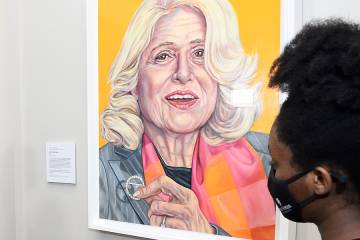- Name
- Johns Hopkins Media Relations
- jhunews@jhu.edu
- Office phone
- 443-997-9009
Johns Hopkins University installed a portrait Wednesday honoring the late Congressman Elijah E. Cummings, the longtime public servant from Baltimore who rose to become one of the most powerful and prominent figures in Congress while remaining a visible and vocal leader for his hometown and its residents.
The portrait—commissioned by the university to celebrate Cummings' life and enduring legacy created by Baltimore artist Christopher Batten—features the light-drenched face of Cummings in profile in the foreground, an American flag and a Baltimore rowhouse street scene behind him. It will hang in the Milton S. Eisenhower Library on the university's Homewood campus.
Speakers at Wednesday's installation—attended by members of Cummings' family; Hopkins faculty, staff, students; local art enthusiasts; and members of the university's board of trustees—included Batten; Maya Rockeymore Cummings, widow of the late congressman; and JHU President Ron Daniels. The event also featured a performance by student a cappella group Notes of Ranvier.
"It is hard to imagine that any portrait could fully capture the dynamism of Elijah, who was a tireless public servant, a steadfast champion of civil rights, a faithful and devoted son of Baltimore, and a great believer in the power of all people to reach their fullest potential," Daniels said. "But Christopher, you've done it. This portrait does not simply seek to represent a single man. It is, as Elijah would have wished it to be, a portrait that captures not only what he stood for but, as importantly, who he stood for."
Cummings, a Baltimore native, died at 68 in October 2019, when was in his 12th term in the U.S. House of Representatives serving Maryland's 7th Congressional District—which includes the university's Baltimore campuses.
Cummings was born in Baltimore in 1951, the third of seven children. He graduated with honors from Baltimore City College high school in 1969, earned a bachelor's degree in political science from Howard University in 1973, and earned a JD from the University of Maryland School of Law in 1976. He spent 14 years as a member of the Maryland House of Delegates before being elected to Congress in 1996. He served as chair of the House Committee on Oversight and Reform while regularly appearing at community events and commuting to and from Washington, D.C., from his home in West Baltimore.
Cummings was a frequent guest and speaker at Johns Hopkins events over the years and a steadfast supporter of the institution's community efforts, including the HopkinsLocal and BLocal economic inclusion initiatives, the Vision for Baltimore program, and the Henderson-Hopkins School in East Baltimore, where Batten's portrait was first unveiled in January. Portraits created by Henderson-Hopkins students in grades K-7 are also be on display at MSE Library.

Image caption: Maya Rockeymoore Cummings (left), widow of the late Congressman Elijah Cummings, and artist Christopher Batten stand next to a portrait of Cummings in the Milton S. Eisenhower Library at Johns Hopkins University.
Image credit: Will Kirk / Johns Hopkins University
Cummings received an honorary degree from Johns Hopkins University in 2015 and served as the featured speaker at the universitywide Commencement ceremony that same year.
The commissioning of the portrait emerged from the ongoing efforts to recognize and elevate diverse people from the university's history in more tangible ways, which includes the work of the Hopkins Portrait Initiative Committee, as well as the Diverse Names and Narratives Project.
Posted in Arts+Culture, University News
Tagged baltimore, art, elijah cummings










